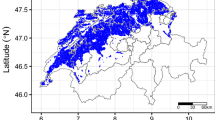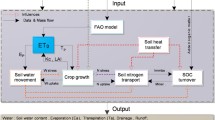Summary
Surface residue is an integral part of many cropping systems, and there are opportunities to optimise its value as mulch by improving our understanding of how it affects the near surface soil physical environment. In this study we use field measurements and a coupled soil heat and water flow model to demonstrate the effects of partial surface mulch on the near surface soil physical environment. The model is based on general physical laws and allows analysis of general system behaviour in response to changes in both inputs and systems variables. The field measurements were obtained on both a clay and a sand soil from experiments carried out in the semi-arid tropics. The treatments included a bare soil surface and 0 (completely mulched), 5 cm and 15 cm bare row zones. Both measurements and simulations showed that partial surface mulch cover can have dramatic effects on the soil physical environment near the soil surface, with the development of very strong horizontal gradients across bare soil—mulched soil boundaries. They also show that bare row zones are able to act as either a source or sink for heat and water, and that the resultant soil environmental conditions will exert strong control of soil biological activity. Although model simulations did not always match exactly with the specific measurements, they did capture the major trends given by the field data. While this suggests a certain robustness about the way the processes are modeled, there are several areas in which the model needs improvement and these are highlighted in the paper.
Similar content being viewed by others
References
Abrecht, D. G., Bristow, K. L., 1990: Maize seedling response to the soil environment at varying distances from a mulched soil-bare soil boundary.Soil Tillage Res. 15, 205–216.
Binley, A. M., Bevan, K. J., Calver, A., Watts, L. G., 1991: Changing responses in hydrology: Assessing the uncertainty in physically based model predictions.Water Resources Res. 27, 1253–1261.
Bond, J. J., Willis, W. O., 1969: Soil water evaporation: Surface residue rate and placement effects.Soil Sci. Soc. Amer. Proc. 33, 445–448.
Bond, J. J., Willis, W. O., 1970: Soil water evaporation: First stage drying as influenced by surface residue and evaporation potential.Soil Sci. Soc. Amer. Proc. 34, 924–928.
Bristow, K. L., 1988: The role of mulch and its architecture in modifying soil temperature.Aust. J. Soil Res. 26, 269–280.
Bristow, K. L., 1992: Prediction of daily mean vapor density from daily minimum air temperature.Agric. Forest Meteor. 59, 309–317.
Bristow, K. L., Abrecht, D. G., 1989: The physical environment of two semi-arid tropical soils with partial surface mulch cover.Aust. J. Soil Res. 27, 577–587
Bristow, K. L., Abrecht, D. G., 1991: Daily temperature extremes as an indicator of high temperature stress.Aust. J. Soil Res. 29, 377–385.
Bristow, K. L., Campbell, G. S., Papendick, R. I., Elliott, L. F., 1986: Simulation of heat and moisture transfer through a surface residue-soil system.Agric. Forest Meteor. 36, 193–214.
Campbell, G. S., 1977:An Introduction to Environmental Biophysics. New York: Springer 159 pp.
Campbell, G. S., 1985:Soil Physics with BASIC—Transport Models for Soil-plant Systems. New York: Elsevier, 150 pp.
Chaves, H. M. L., Nearing, M. A., 1991: Uncertainty analysis of the WEPP soil erosion model.Trans. Amer. Soc. Agric. Eng. 34, 2437–2444.
de Vries, D. A., 1963: Thermal properties of soils. In: van Wijk, W. R., (ed.)Physics of Plant Environment, Amsterdam: North Holland, pp. 210–235.
Chung, S. O., Horton, R., 1987: Soil heat and water flow with a partial surface mulch.Water Resources Res. 23, 2175–2186.
Ham, J. M., Heilman, J. L., Lascano, R. J., 1991: Soil and canopy energy balances of a new crop at partial cover.Agron. J. 83, 744–753.
Hares, M. A., Novak, M. D., 1992a: Simulation of surface energy balance and soil temperature under strip tillage I Model description.Soil Sci. Soc. Amer. J. 56, 22–29.
Hares, M. A., Navak, M. D., 1992b: Simulation of surface energy balance and soil temperature under strip tillage II Field test.Soil Sci. Soc. Amer. J. 56, 29–36.
Heilman, J. L., McInnes, K. J., Gesch, R. W., Lascano, R. J., 1992: Evaporation from ridge-tilled soil covered with herbicide-killed winter wheat.Soil Sci. Soc. Amer. J. 56, 1278–1286.
Horton, R., Kluitenberg, G. J., Bristow, K. L., 1994: Surface crop residue effects on the soil surface energy balance. In: Unger, P. W. (ed.),Managing Agricultural Residues. Boca Raton: Lewis Publishers, pp. 143–162.
Jackson, R. D., Reginato, R. J., Kimball, B. A., Nakayama, F. S., 1974: Diurnal soil water evaporation: comparison of measured and calculated soil water fluxes.Soil Sci. Soc. Amer. Proc. 38, 861–866.
Kluitenberg, G. J., Horton, R., 1990: Analytical solution for two-dimensional heat conduction beneath a partial surface mulch.Soil Sci. Soc. Amer. J. 54, 1197–1206.
Klute, A. (ed.), 1986:Methods of Soil Analysis, Part I Physical and Mineralogical Methods 2nd edn. Agronomy 9, American Society of Agronomy, Madison.
Lapidus, L., Pinder, G. F., 1982:Numerical Solution of Partial Differential Equations in Science and Engineering. New York: Wiley-Interscience, 667 pp.
McCown, R. L., Jones, R. K., Peake, D. C., 1980: Evaluation of a no-till, tropical legume ley-farming strategy. In: Muchow, R. C., (ed.)Agro-research for the Semi-arid Tropics: Northwest Australia. St. Lucia: University of Queensland Press, pp. 450–469.
Philip, J., de Vries, D. A., 1957: Moisture movement in porous materials under temperature gradients.Eos Trans. AGU 38, 222–232.
Radke, J. K., 1982: Managing early season soil temperatures in the northern corn belt using configured soil surfaces and mulches.Soil Sci. Soc. Amer. J. 46, 1067–1071.
Ross, P. J., Williams, J., McCown, R. L., 1985: Soil temperature and the energy balance of vegetative mulch in the semi-arid tropics II Dynamic Analysis of the total energy balance.Aust. J. Soil Res. 23, 515–532.
Saxton, K. E., Bristow, K. L., Flerchinger, G., Omar, M., 1988: Tillage and crop residue management for water conservation. In: Unger, P. W., Sneed, T. V., Jordan, W. R., Jensen, R. (eds.)Challenges in Dryland Agriculture — A Global Perspective. College Station: Texas Agricultural Experiment Station, pp. 494–496.
Shen, Y., Tanner, C. B., 1990: Radiative and conductive transport of heat through flail-chopped corn residue.Soil Sci. Soc. Amer. J. 54, 653–658.
Tanner, C. B., Shen, Y., 1990a: Solar radiation transmittance of fail-chopped corn residue layers.Soil Sci. Soc. Amer. J. 54, 650–652.
Tanner, C. B., Shen, Y., 1990b: Water vapor transport through a flail-chopped corn residue.Soil Sci. Soc. Amer. J. 54, 945–951.
Unger, P. W., Parker, J. J., 1976: Evaporation reduction from soil with wheat, sorghum, and cotton residues.Soil Sci. Soc. Amer. J. 40, 938–942.
van Bavel, C. H. M., Hillel, D. L., 1976: Calculating potential and actual evaporation from a bare soil surface by simulation of concurrent flow of water and heat.Agric. Meteor. 17, 453–476.
van Genuchten, M. T., 1980: A closed-form equation for predicting the hydraulic conductivity of unsaturated soils.Soil. Sci. Soc. Amer. J. 44, 892–898.
Williams, J., Ross, P. J., Bristow, K. L., 1991: Perspicacity, precision and pragmatism in modeling crop water supply. In: Muchow, R. C., Bellamy, J. A. (eds.)Climatic Risk in Crop Production Models and Management for the Semiarid Tropics and Subtropics. Wallingford: C.A.B. International, pp. 73–96.
Author information
Authors and Affiliations
Additional information
Journal Paper No. J16277 of the Iowa Agricultural Home Economics Experiment Station, Ames, IA.
With 9 Figures
Rights and permissions
About this article
Cite this article
Bristow, K.L., Horton, R. Modeling the impact of partial surface mulch on soil heat and water flow. Theor Appl Climatol 54, 85–98 (1996). https://doi.org/10.1007/BF00863561
Received:
Revised:
Issue Date:
DOI: https://doi.org/10.1007/BF00863561




